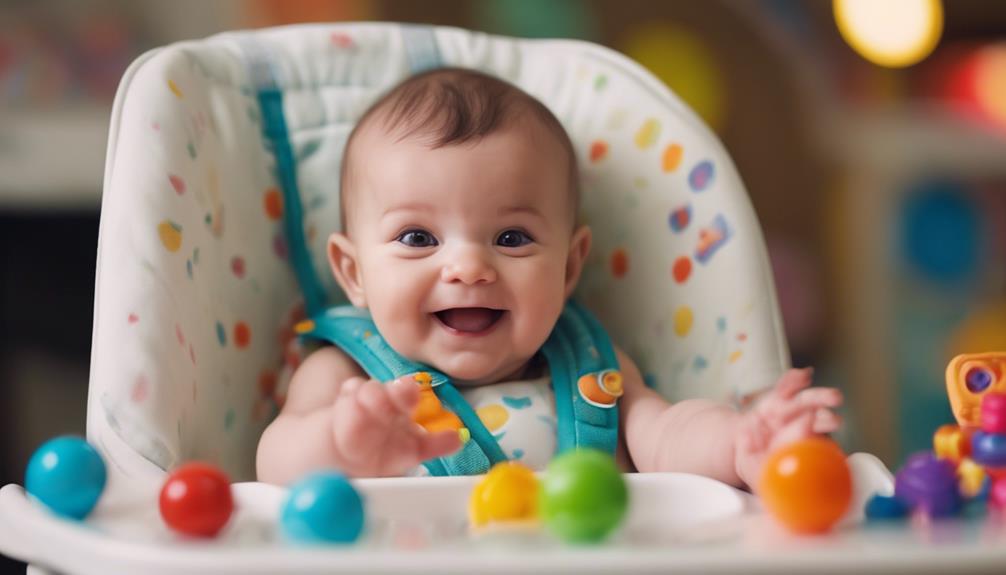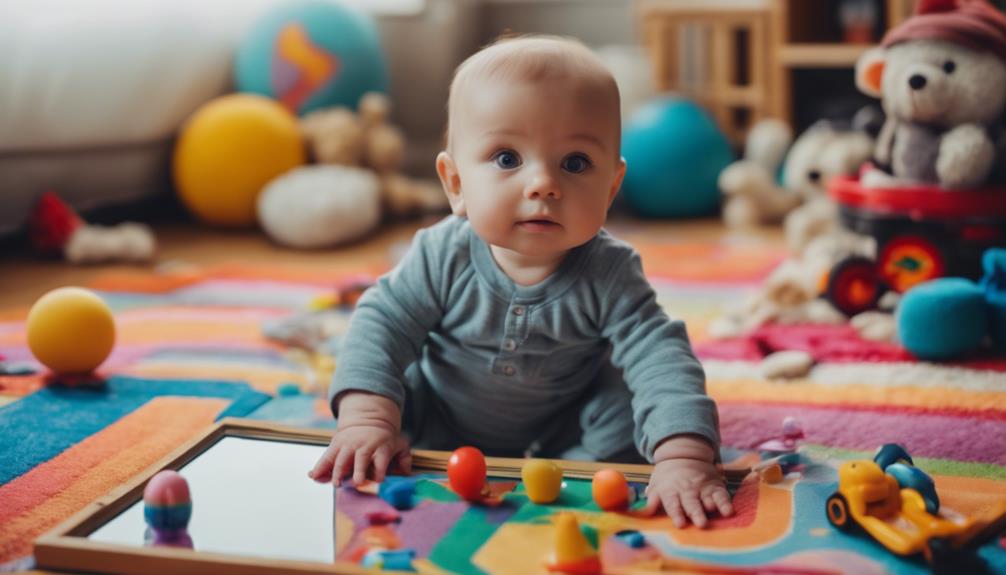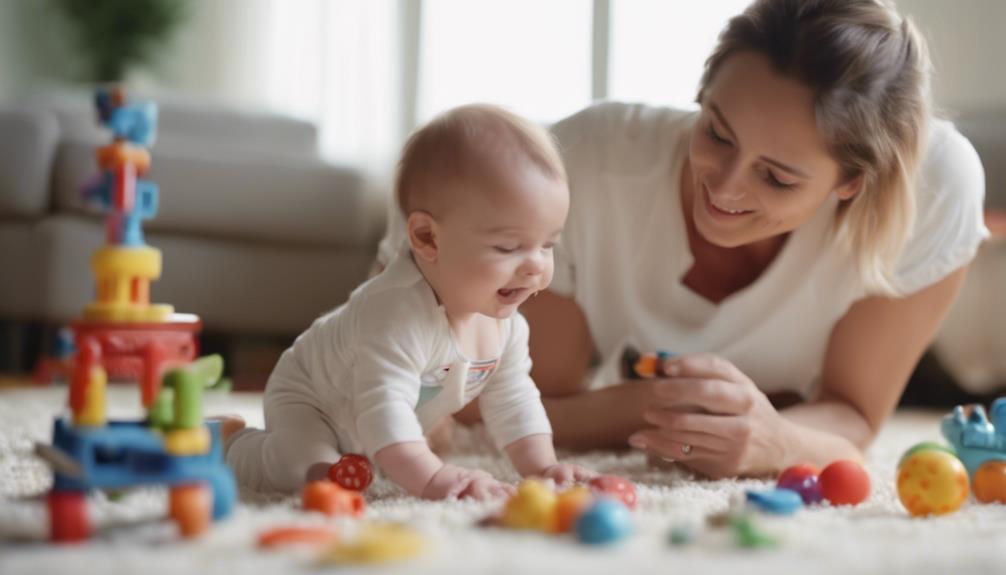By 6 months, your baby demonstrates cognitive advancement in visual tracking, recognizing faces, and depth perception. Socially, they participate in interactions and react to changes in voice tones. Their problem-solving skills improve as they grasp the concept of cause and effect. Sensorimotor skills progress as they grasp and interact with toys. Language development begins with babbling, improving their communication abilities. Memory recognition starts to develop as they become familiar with faces and objects. These achievements establish a solid groundwork for their future growth and learning.
Key Takeaways
- Object permanence develops.
- Cause and effect understanding.
- Advancements in sensorimotor skills.
- Babbling for communication.
- Recognition of familiar faces.
Visual Tracking and Object Recognition
Enhance your baby's cognitive development by understanding the significance of visual tracking and object recognition in their first six months. Visual tracking allows infants to follow moving objects and faces, improving their focus and ability to engage with stimuli.
Around 4 months old, babies begin recognizing familiar faces and objects, showcasing early signs of memory and cognitive development. This recognition lays the groundwork for future learning processes.
By 6 months, infants can track objects with both eyes, enhancing their depth perception and visual coordination skills. Developing these skills early on is vital for the growth of cognitive abilities.
Encouraging visual engagement through colorful toys and interactions supports the advancement of infants' visual tracking and recognition abilities. By providing stimulating visual experiences, you can help your baby develop essential skills that will aid them in their cognitive growth and understanding of the world around them.
Social Interaction and Communication

At 6 months old, your baby may be engaging in simple back-and-forth interactions, like babbling in response to conversation cues. This marks an exciting milestone in their social development.
Additionally, by this age, babies are more responsive to different tones of voice, enhancing their communication skills.
Early Babbling Development
Early babbling at 4-6 months allows infants to explore various sounds and tones, laying the groundwork for enhanced social interaction and communication skills. Babbling is a pivotal step in language development, indicating your baby's budding communication abilities. Through babbling, babies practice vocalization, engage in social interactions, and learn the basics of turn-taking in conversations.
Encouraging your little one's early babbling by responding to their sounds and actively participating in verbal exchanges can further foster their language skills. This initial vocal experimentation sets the stage for future language acquisition and expression in infants. By engaging with your baby during their babbling stage, you aren't only encouraging their communication skills but also strengthening the bond between you and your little one.
Responsive to Voices
By 2 months old, babies typically start turning their heads towards voices and sounds, showing an early interest in human communication. Infants at this age are becoming more responsive to the voices around them, often reacting with delightful coos and smiles.
You may notice your baby becoming more attentive when you speak to them, as they try to imitate the sounds they hear. This responsiveness to voices is a critical milestone in their communication development, laying the groundwork for language acquisition.
Social interactions through verbal communication play a significant role in helping your baby bond with you and other caregivers, fostering emotional connections that are essential for their overall development. Encouraging this interest in voices and sounds by engaging in conversations and reading to your baby can further support their language skills and strengthen your bond with them.
Cognitive Development and Problem-Solving
At 6 months old, your baby may start to develop object permanence, understanding that objects still exist even when out of sight.
They might begin to grasp cause and effect relationships, like realizing that pressing a button makes a toy light up.
Encouraging problem-solving skills through interactive play can further enhance your baby's cognitive development at this stage.
Object Permanence Development
Understanding object permanence, the concept that objects continue to exist even when not in view, is a significant cognitive milestone in a 6-month-old baby's development. This milestone marks the beginning of your baby's mental representation of hidden objects, enhancing problem-solving skills and memory formation.
Here are some ways to support your baby's object permanence development:
- Engage in activities like peek-a-boo to help your baby grasp the idea that objects still exist even when they can't be seen.
- Hide toys under cups or blankets for your baby to find, encouraging them to search for hidden objects.
- Observe your baby's reactions when objects disappear or reappear, as this shows their growing understanding of object permanence.
- Encourage your baby to reach for toys that have been covered, fostering their problem-solving abilities and memory retention.
Cause and Effect
Developing an understanding of cause and effect is an essential aspect of cognitive development and problem-solving skills in infants around 4-6 months old.
At this stage, babies begin to grasp cause and effect relationships, like shaking a rattle to produce sound. You might notice your little one repeating actions to observe the same result, showing early signs of problem-solving skills.
Simple interactive games such as peek-a-boo can help reinforce this concept in their cognitive development. Understanding cause and effect is vital for infants as it aids them in making sense of the world around them.
To further enhance their comprehension, encourage exploration and provide toys that respond to their actions. By engaging with toys that react to their movements, infants can deepen their understanding of how their actions lead to specific outcomes, laying a foundation for more advanced problem-solving skills in the future.
Problem-Solving Skills
Infants around 4-6 months old start to exhibit early problem-solving skills by actively exploring objects in their environment. As your baby grows, their problem-solving abilities also develop. Here's what to expect in this exciting phase:
- Reaching Milestone: By 6-8 months, your little one may start reaching for out-of-reach objects, showcasing their problem-solving skills in action.
- Manipulating Objects: Around 6-8 months, babies may show their problem-solving abilities by manipulating toys or objects to achieve a desired outcome.
- Understanding Cause and Effect: At 8-10 months, infants begin to grasp cause and effect relationships, a significant cognitive development milestone.
- Trial-and-Error Methods: By 10-12 months, your baby may engage in problem-solving tasks like fitting objects into containers, using trial-and-error methods to solve puzzles.
Through these milestones, your baby's cognitive development flourishes as they navigate the world around them, honing their problem-solving skills with each new challenge.
Sensorimotor Skills and Hand-Eye Coordination

By 6 months, babies demonstrate significant advancements in their sensorimotor skills and hand-eye coordination, engaging in activities such as grasping objects and exploring textures through touch. Their hand-eye coordination improves as they reach for objects, track moving items, and pick up small objects.
Babies start developing the pincer grasp, using their thumb and forefinger to pick up tiny items. They explore toys with their hands, banging objects together and transferring them from hand to hand.
To support their sensorimotor development, provide toys of various shapes, textures, and sizes for exploration. Encouraging activities that involve passing toys between hands can also enhance their hand-eye coordination.
As babies continue to grow, these skills will lay a solid foundation for more complex movements and interactions with their environment. Keep fostering their curiosity and exploration to help them further develop these essential abilities.
Language Acquisition and Babbling

Around 6 months, babies typically start babbling, experimenting with sounds like 'ba,' 'ma,' and 'da,' as they begin their journey of language acquisition.
Here are some key points to keep in mind about language acquisition and babbling:
- Essential Development: Babbling serves as a vital step in language development, helping babies in practicing mouth movements and vocalizations.
- Imitation and Progress: By 12 months, babies may mimic simple words and gestures, indicating advancements in language acquisition.
- Communication Foundation: Babbling enables babies to express their needs and feelings, laying the groundwork for future language skills.
- Bond Strengthening: Encouraging and responding to a baby's babbling not only supports language development but also enhances the parent-child bond.
Engaging with your baby during their babbling stage can nurture their communication skills and strengthen your relationship. It's an exciting time as you observe your little one start on their language journey.
Memory Development and Recognition Skills
Developing memory and recognition skills in your 6-month-old baby play an essential role in their cognitive growth and bonding with caregivers. Infants at this age start to exhibit signs of memory development by recognizing familiar faces, such as parents and caregivers. They may also display early understanding of object permanence, realizing that objects exist even when out of sight. By anticipating routines like bedtime or feeding times, babies show their growing memory capacity. Around six months, infants can differentiate between familiar and unfamiliar faces, showcasing their recognition skills. Memory development in babies is fundamental for laying the groundwork for cognitive skills and forming strong relationships with their caregivers.
| Memory Development and Recognition Skills |
|---|
| – Recognizing familiar faces |
| – Understanding object permanence |
| – Anticipating routines |
Frequently Asked Questions
What Can a 1 Month Old Do Intellectually?
At one month old, you can focus on objects up to 12 inches away, follow them with your eyes, respond to sound by startling or turning your head, distinguish between smells, and begin making cooing sounds.
What Are Four Signs of Intellectual Growth in an Infant?
You can notice intellectual growth in infants through their responses to sounds, recognizing faces, tracking moving objects, and showing curiosity about their surroundings. These signs reflect the beginning of their cognitive development and understanding of the world.
What Are the Intellectual Skills of a Newborn?
You recognize a newborn's intellectual skills through their ability to make eye contact, focus on faces, and track movements. They display curiosity, imitate facial expressions, respond to stimuli, and differentiate familiar voices, laying the foundation for future development.
What Milestones Should a 1 Month Old Have?
You should notice your one-month-old baby focusing on objects, making eye contact, and displaying early social behaviors like smiling and cooing. While each baby progresses differently, these milestones are commonly seen in infants at this age.
Conclusion
Well, congratulations! Your 6-month-old baby is well on their way to becoming a little genius.
From tracking objects to babbling away, they're hitting all the key intellectual milestones.
Just remember to keep engaging with them and providing plenty of opportunities for learning and exploration.
Before you know it, they'll be running circles around you with their newfound cognitive skills.
Happy parenting!










